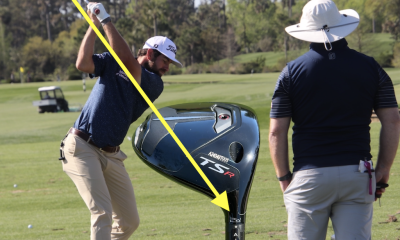Opinion & Analysis
A True Story About Putters (Part 1)

“Ball on Green,” or putting, is a statistical environment of its own and was my introduction into the golf equipment business. A mutual friend introduced me to Dave Pelz more than 40 years ago, saying that as two equipment nuts we deserved each other. At the time I fooled around with ideas, but Dave was the real thing with his own booth at the annual PGA Merchandise show.
I started attending the Show with him on my own nickel and years later ended up working full time with Dave in Abilene, Texas. I mention this only as background to my years of study on putting implements, both how and why they work. Unlike Dave, I didn’t focus on the putting stroke. My world was what happened when the club head contacted the ball and how that relationship could be optimized.
Now fast forward some 44 years and my phone rings. I’m retired and concentrating on how to drive the ball distances that violate the laws of physics given my club head speed. It’s an old friend from the golf business and after a bit of reminiscing he says, “Barnyard I have someone you must talk to. He has invented the best putter ever designed.”
That got my attention immediately, because my friend was not unknowledgeable and conversely I did not believe there was such a thing as one putter that was significantly better than others. That thought was my little secret which I did not divulge.
My friend went on to explain that the person who designed the putter was a certified genius with an IQ well over 200. As some intellectuals are inclined, he was not given to sympathy toward those with lesser intellect. The obvious problem ahead was that you could hit a wedge between our IQ’s, however, my friend assured me that he had prepared the genius. I was lacking in many areas, but I did know putters and could render an honest evaluation.
We agreed on a time and date and as a favor to my friend I called the designer. It took maybe 15 seconds for me to realize that this person was very uncomfortable speaking with someone well below his intellectual level and I had to get on common ground. I asked him to explain his design to me.
The concept revolved around optimum torsional effectiveness, or “forgiveness on off center hits” as it’s more commonly known. I immediately thought of the Bulls Eye putter that was designed in the 40’s. It’s a putter that’s still used on Tour by some players, and Johnny Miller shot his famed 63 at Oakmont in the ’73 Open with one.
The Bulls Eye is not exactly the epitome of torsional effectiveness, but I wasn’t going to open that door — questioning his design would be tantamount to a personal attack. So I asked him what loft he had on his standard model and he said, “Zero of course. The design precludes the need for face loft, something I have tested extensively.”
I then asked how he conducted his tests and he said, “On a pool table, to understand the performance of the head the testing environment must be perfect.”
He didn’t say, “You dolt,” but the inflection was there.
Up to that point I was on my good behavior, but admittedly diplomacy is not my strong suit.
[quote_box_center]”I’m sorry, but your premise of no loft is incorrect and your testing environment is not applicable,” I said. “Your putter design has a fatal flaw.”[/quote_box_center]
You could hear a sharp intake of breath.
[quote_box_center]”Why don’t you explain the technical reasons behind your comment,” he said, his words heavy with sarcasm.[/quote_box_center]
It didn’t take me long.
[quote_box_center]”Putting is about controlling speed,” I said. “Some surfaces are excellent, some shall we say politely are less so. On the green the ball is sitting down in the grass and needs to get up onto the surface so it can roll on its axis and have minimal influence from imperfections. Depending on the quality of the surface, a launch angle off the face between 1.25 and 1.75 degrees is optimal (I thought I’d throw that in to try and penetrate his air of superiority). To do so, you must have face loft ideally matching the putting surface.”[/quote_box_center]
I was prepared to supply more of my putter design knowledge, but he had heard enough — which was basically that I disagreed with him, an unacceptable position.
In a thinly disguised effort to hide his disapproval, he ended the conversation making it clear there would be nothing further worth discussion. I told my friend the story and that I had to be honest about what I knew to be true. He said not to worry; they had found a wealthy individual who loved golf and they thought he was going to invest.
They were right — he did and the operation busted out (and to repeat this is a true story).
To be continued…
Opinion & Analysis
The 2 primary challenges golf equipment companies face

As the editor-in-chief of this website and an observer of the GolfWRX forums and other online golf equipment discourse for over a decade, I’m pretty well attuned to the grunts and grumbles of a significant portion of the golf equipment purchasing spectrum. And before you accuse me of lording above all in some digital ivory tower, I’d like to offer that I worked at golf courses (public and private) for years prior to picking up my pen, so I’m well-versed in the non-degenerate golf equipment consumers out there. I touched (green)grass (retail)!
Complaints about the ills of and related to the OEMs usually follow some version of: Product cycles are too short for real innovation, tour equipment isn’t the same as retail (which is largely not true, by the way), too much is invested in marketing and not enough in R&D, top staffer X hasn’t even put the new driver in play, so it’s obviously not superior to the previous generation, prices are too high, and on and on.
Without digging into the merits of any of these claims, which I believe are mostly red herrings, I’d like to bring into view of our rangefinder what I believe to be the two primary difficulties golf equipment companies face.
One: As Terry Koehler, back when he was the CEO of Ben Hogan, told me at the time of the Ft Worth irons launch, if you can’t regularly hit the golf ball in a coin-sized area in the middle of the face, there’s not a ton that iron technology can do for you. Now, this is less true now with respect to irons than when he said it, and is less and less true by degrees as the clubs get larger (utilities, fairways, hybrids, drivers), but there remains a great deal of golf equipment truth in that statement. Think about it — which is to say, in TL;DR fashion, get lessons from a qualified instructor who will teach you about the fundamentals of repeatable impact and how the golf swing works, not just offer band-aid fixes. If you can’t repeatably deliver the golf club to the golf ball in something resembling the manner it was designed for, how can you expect to be getting the most out of the club — put another way, the maximum value from your investment?
Similarly, game improvement equipment can only improve your game if you game it. In other words, get fit for the clubs you ought to be playing rather than filling the bag with the ones you wish you could hit or used to be able to hit. Of course, don’t do this if you don’t care about performance and just want to hit a forged blade while playing off an 18 handicap. That’s absolutely fine. There were plenty of members in clubs back in the day playing Hogan Apex or Mizuno MP-32 irons who had no business doing so from a ballstriking standpoint, but they enjoyed their look, feel, and complementary qualities to their Gatsby hats and cashmere sweaters. Do what brings you a measure of joy in this maddening game.
Now, the second issue. This is not a plea for non-conforming equipment; rather, it is a statement of fact. USGA/R&A limits on every facet of golf equipment are detrimental to golf equipment manufacturers. Sure, you know this, but do you think about it as it applies to almost every element of equipment? A 500cc driver would be inherently more forgiving than a 460cc, as one with a COR measurement in excess of 0.83. 50-inch shafts. Box grooves. And on and on.
Would fewer regulations be objectively bad for the game? Would this erode its soul? Fortunately, that’s beside the point of this exercise, which is merely to point out the facts. The fact, in this case, is that equipment restrictions and regulations are the slaughterbench of an abundance of innovation in the golf equipment space. Is this for the best? Well, now I’ve asked the question twice and might as well give a partial response, I guess my answer to that would be, “It depends on what type of golf you’re playing and who you’re playing it with.”
For my part, I don’t mind embarrassing myself with vintage blades and persimmons chasing after the quasi-spiritual elevation of a well-struck shot, but that’s just me. Plenty of folks don’t give a damn if their grooves are conforming. Plenty of folks think the folks in Liberty Corner ought to add a prison to the museum for such offences. And those are just a few of the considerations for the amateur game — which doesn’t get inside the gallery ropes of the pro game…
Different strokes in the game of golf, in my humble opinion.
Anyway, I believe equipment company engineers are genuinely trying to build better equipment year over year. The marketing departments are trying to find ways to make this equipment appeal to the broadest segment of the golf market possible. All of this against (1) the backdrop of — at least for now — firm product cycles. And golfers who, with their ~15 average handicap (men), for the most part, are not striping the golf ball like Tiger in his prime and seem to have less and less time year over year to practice and improve. (2) Regulations that massively restrict what they’re able to do…
That’s the landscape as I see it and the real headwinds for golf equipment companies. No doubt, there’s more I haven’t considered, but I think the previous is a better — and better faith — point of departure when formulating any serious commentary on the golf equipment world than some of the more cynical and conspiratorial takes I hear.
Agree? Disagree? Think I’m worthy of an Adam Hadwin-esque security guard tackle? Let me know in the comments.
@golfoncbs The infamous Adam Hadwin tackle ? #golf #fyp #canada #pgatour #adamhadwin ? Ghibli-style nostalgic waltz – MaSssuguMusic
Podcasts
Fore Love of Golf: Introducing a new club concept

Episode #16 brings us Cliff McKinney. Cliff is the founder of Old Charlie Golf Club, a new club, and concept, to be built in the Florida panhandle. The model is quite interesting and aims to make great, private golf more affordable. We hope you enjoy the show!
Opinion & Analysis
On Scottie Scheffler wondering ‘What’s the point of winning?’

Last week, I came across a reel from BBC Sport on Instagram featuring Scottie Scheffler speaking to the media ahead of The Open at Royal Portrush. In it, he shared that he often wonders what the point is of wanting to win tournaments so badly — especially when he knows, deep down, that it doesn’t lead to a truly fulfilling life.
View this post on Instagram
“Is it great to be able to win tournaments and to accomplish the things I have in the game of golf? Yeah, it brings tears to my eyes just to think about it because I’ve literally worked my entire life to be good at this sport,” Scheffler said. “To have that kind of sense of accomplishment, I think, is a pretty cool feeling. To get to live out your dreams is very special, but at the end of the day, I’m not out here to inspire the next generation of golfers. I’m not out here to inspire someone to be the best player in the world, because what’s the point?”
Ironically — or perhaps perfectly — he went on to win the claret jug.
That question — what’s the point of winning? — cuts straight to the heart of the human journey.
As someone who’s spent over two decades in the trenches of professional golf, and in deep study of the mental, emotional, and spiritual dimensions of the game, I see Scottie’s inner conflict as a sign of soul evolution in motion.
I came to golf late. I wasn’t a junior standout or college All-American. At 27, I left a steady corporate job to see if I could be on the PGA Tour starting as a 14-handicap, average-length hitter. Over the years, my journey has been defined less by trophies and more by the relentless effort to navigate the deeply inequitable and gated system of professional golf — an effort that ultimately turned inward and helped me evolve as both a golfer and a person.
One perspective that helped me make sense of this inner dissonance around competition and our culture’s tendency to overvalue winning is the idea of soul evolution.
The University of Virginia’s Division of Perceptual Studies has done extensive research on reincarnation, and Netflix’s Surviving Death (Episode 6) explores the topic, too. Whether you take it literally or metaphorically, the idea that we’re on a long arc of growth — from beginner to sage elder — offers a profound perspective.
If you accept the premise literally, then terms like “young soul” and “old soul” start to hold meaning. However, even if we set the word “soul” aside, it’s easy to see that different levels of life experience produce different worldviews.
Newer souls — or people in earlier stages of their development — may be curious and kind but still lack discernment or depth. There is a naivety, and they don’t yet question as deeply, tending to see things in black and white, partly because certainty feels safer than confronting the unknown.
As we gain more experience, we begin to experiment. We test limits. We chase extreme external goals — sometimes at the expense of health, relationships, or inner peace — still operating from hunger, ambition, and the fragility of the ego.
It’s a necessary stage, but often a turbulent and unfulfilling one.
David Duval fell off the map after reaching World No. 1. Bubba Watson had his own “Is this it?” moment with his caddie, Ted Scott, after winning the Masters.
In Aaron Rodgers: Enigma, reflecting on his 2011 Super Bowl win, Rodgers said:
“Now I’ve accomplished the only thing that I really, really wanted to do in my life. Now what? I was like, ‘Did I aim at the wrong thing? Did I spend too much time thinking about stuff that ultimately doesn’t give you true happiness?’”
Jim Carrey once said, “I think everybody should get rich and famous and do everything they ever dreamed of so they can see that it’s not the answer.”
Eventually, though, something shifts.
We begin to see in shades of gray. Winning, dominating, accumulating—these pursuits lose their shine. The rewards feel more fleeting. Living in a constant state of fight-or-flight makes us feel alive, yes, but not happy and joyful.
Compassion begins to replace ambition. Love, presence, and gratitude become more fulfilling than status, profits, or trophies. We crave balance over burnout. Collaboration over competition. Meaning over metrics.
Interestingly, if we zoom out, we can apply this same model to nations and cultures. Countries, like people, have a collective “soul stage” made up of the individuals within them.
Take the United States, for example. I’d place it as a mid-level soul: highly competitive and deeply driven, but still learning emotional maturity. Still uncomfortable with nuance. Still believing that more is always better. Despite its global wins, the U.S. currently ranks just 23rd in happiness (as of 2025). You might liken it to a gifted teenager—bold, eager, and ambitious, but angsty and still figuring out how to live well and in balance. As much as a parent wants to protect their child, sometimes the child has to make their own mistakes to truly grow.
So when Scottie Scheffler wonders what the point of winning is, I don’t see someone losing strength.
I see someone evolving.
He’s beginning to look beyond the leaderboard. Beyond metrics of success that carry a lower vibration. And yet, in a poetic twist, Scheffler did go on to win The Open. But that only reinforces the point: even at the pinnacle, the question remains. And if more of us in the golf and sports world — and in U.S. culture at large — started asking similar questions, we might discover that the more meaningful trophy isn’t about accumulating or beating others at all costs.
It’s about awakening and evolving to something more than winning could ever promise.






















BIG STU
Apr 25, 2015 at 5:27 am
It all boils down to a couple of thing one of them being common sense and common business sense. Barney seems to have both IMHO. He just stated the facts from his common and business experiences in the golf industry. And I will make a comment on the loft thing and it is a common phrase different strokes for different folks. I for one forward press and hold it at impact so I need a putter set at around 3.5* static where someone who does not forward press will need less. That is why you have club fitters and putter bending machines. To get back to the original topic you have to find a niche for any product whether it is in golf or widgets. I would have to say Barney knows his stuff
Rhoward
Jan 27, 2015 at 8:56 am
IQ’s value itself is debatable. IQ in the beginning was useful. It was developed by the Army to judge whether a soldier could handle explosives and the alike. The original scale does not go above 135 nor below 65. Only 3% are above or below those values. The value of an IQ above 135 is not given by the original design. Einstein’s IQ is in question given the new evidence in Israel’s archives — love letters showing his first wife came up with key ideas, and all the surviving physics notes that are hand written are in the wife’s handwriting. During the Manhattan Project and again when the Space Shuttle blew up — the big wigs (super high IQ’d physicists) debated the whys and wherefores. Socially, high IQ club membership usually takes hundreds of hours of practice testing to gain membership (yes, it’s a learned behavior). The great industrial epoch makers like Edison, Bell and Tesla would not have tested well; their knowledge was too single minded and their personalities too irascible. Lastly, child geniuses have not shown to achieve much when grown. This is all to say that Adams is right — the best ideas of engineering are forged in the heat of argument between like minded but tolerant mechanically minded individuals. The Wright Brothers debated fiercely for hours, days and even weeks on end over the smallest design details. They constructed their own primitive wind tunnels to help settle those fist pumping mental wrestling matches.
Bread
Jan 26, 2015 at 4:08 pm
Einstein had an IQ of 160. An IQ over 200 has been recorded exactly 3 times…
holly
Jan 13, 2015 at 9:30 pm
david kargetta? black swan?
guy couldnt hear a question, let alone a differing opinion
bradford
Jan 8, 2015 at 1:03 pm
I find I putt better when I rub my older cat with my putter. It is important to note this does NOT work with the kitten.
I can promise that anyone who putts with MOI, spin, torsion, and loft in mind hasn’t putted well in years.
Gotta love your putter.
.
bradford
Jan 8, 2015 at 1:08 pm
oh, and there are ~15 living people with IQ’s at 200+. I doubt seriously any of them is going into (and failing at) the gimmicky putter industry. Not when they can make HUGE money in the gimmicky pharma industry.
Paul
Jan 7, 2015 at 5:10 pm
Love it, ‘Barnyard’!
Can’t wait for the next chapter.
ca1879
Jan 7, 2015 at 4:23 pm
Barney – are you ready to accept yet that no amount of straight talk and factual information will change a believers mind? Almost all golf related businesses fail or struggle, but telling an ambitious entrepreneur that will just harden their resolve to forge ahead. Laying out the facts on golf club performance will only prompt those who think their miracle club has revolutionized some aspect of their game, when they are really just falling prey to the many ways we can all fool ourselves. This unfortunate example, is just a another sad tale in the long list of things we golfers fall for. This con person sold people with no understanding of basic science a product that does not work as claimed (not saying it doesn’t work, but it’s not because of the imaginary zero MOI, or because it resembles a B2 wing) by using a “sciency sounding” line of patter. We’re a pretty gullible lot when you get right down to it, and it’s not just where golf equipment is concerned.
ca1879
Jan 7, 2015 at 4:30 pm
“will only prompt” should be “will not change the minds of”
Barney Adams
Jan 7, 2015 at 10:04 pm
Golfers have passion and when it comes to the business side I try to help them by ” telling it as it is” some are appreciative some call me a wet blanket ( or worse) Years ago a guy came to me with a plan for a putter Infomercial. I explained that he didn’t have enough margin cost to sale price on TV. He got furious said I didn’t want anyone else to have the success I did etc. ( and I mean really angry) He went forward, all in financially. Went bankrupt.
Scott
Jan 8, 2015 at 2:40 pm
Thanks Barney for your articles and stories. Keep them coming!
Jonny B
Jan 7, 2015 at 11:25 am
This story just seems like the ramblings of an old guy. Oh wait, it is.
Not really too familiar with all the technical stuff behind the theory of this article, but I can tell you my putting has dramatically improved using a zero-loft putter by Cure. Take it for what it’s worth. http://cureputters.com/zero-loft-tru-roll.aspx
bradford
Jan 8, 2015 at 12:58 pm
What do I call MY overspin putter? MONEYYYY…
derek
Jan 10, 2015 at 12:49 pm
i got a cure putter on ebay cheap, have u gotten over the aluminum bat sound?
Ken
Jan 7, 2015 at 11:20 am
The best putter is the one that just holed the last 30 footer.
bradford
Jan 8, 2015 at 1:04 pm
^this
Merty Huckle
Jan 7, 2015 at 11:20 am
you know, This is really interesting. At first I was pissed with the To be continued, ut I have to admit I’m hooked.
RG
Jan 7, 2015 at 4:49 am
That guy is crazy!! Personally I’ve found that eye of newt roasted in bats blood lightly sprinkled over your putter while chanting,”Oingo Boingo Bingo Bar, I need a birdie but I’ll take a Par,’ works everytime.
Pooch
Jan 7, 2015 at 9:41 pm
RG,
Now where can I get the Eye of Newt and the Bats Blood? Thanks for the tip.
Pooch
jesse
Jan 9, 2015 at 6:35 am
Now you have me totally confused !
8thehardway
Jan 7, 2015 at 2:40 am
Mad genius with 200 IQ ignores Barney’s good advice, finishes flawed design.
POW!!!
Jack Hamm’s Zero Latitude putter goes on sale (it looks like a 3-foot long hammer)
Jack now doing Tee It Forward promos for Barney
killerbgolfer
Jan 6, 2015 at 11:02 pm
Great story!
Stretch
Jan 6, 2015 at 12:52 pm
A couple of points while waiting for Part 2; loft is needed to get the ball to roll especially on less than perfect greens, the more the MOI in a club the more likely the ball striking becomes poor.
3-4 degrees of loft works best for smooth fast greens as well as grainy slow and bumpy ones. On fast greens the extra loft will let the golfer apply more force to get the same distance. On short side hill putts on fast smooth greens this means the ball will start on the line instead of slightly sliding downhill at the release of the ball off the face causing missed putts unrelated to the quality of the stroke.
Miller’s 63 was with persimmon woods, muscle back irons and the Bulls Eye. All had a small MOI and needed great ball striking to perform.
Sb
Jan 6, 2015 at 6:15 pm
As someone who has studied putting and the technology behind putters and loft specifically, loft is probably the most important individual factor in improving speed or distance control.
Most amateurs buy putters off the rack and generally the putter has somewhere from 2-4*. Add the fact that most of those players add loft at impact and now have effective lofts of 4-6 degrees sometimes! This creates backspin and causes the ball to lose pace and skid offline.
Bottom line is, on green speeds around 10 on average, an effective loft of 1 Degree is ideal for creating neutral launch. So for those golfers, having a static loft on a putter of 0 is necessary to achieve the 1-1.5 degrees of ideal effective loft.
Ponjo
Jan 7, 2015 at 4:12 pm
Indeed. 52years of age and Miller still my favourite ever golfer
Brad Ingarfield
Jan 8, 2015 at 7:54 am
“The more MOI in a club the more likely ball striking becomes poor” – interesting observation. I have often thought about this. Do you have any evidence or is it your opinion? No disrespect intended!
Stretch
Jan 10, 2015 at 11:26 am
The MOI opined about concerns how small headed putters and clubs demand a strike that is solid. Large headed clubs disguise the need for a precise by giving results when missing the sweet spot.
No disrespect taken. 5 decades of playing at and with players in tournaments where the players’ handicaps (if created in the Tour players case) would be +2-+7 range.
jesse
Jan 9, 2015 at 6:48 am
Stretch: When does “Part 2” come around? I’ve been looking all over this website.
Regarding “getting the ball rolling”; I always thought it skidded the first few inches anyway?
Not sure about the mojo of the MOI. If you cannot strike a putt solidly, more than likely it took more than par to get to where you can putt. Not much chance of a 63 there.
So you are advocating using a 3-4 degree putter for “everything”. On those fast greens and applying more force, wouldn’t that possibly cause more “un-solid” hits, or non-solid hits, or miss-hits, and more sidespin (and however slight it might be), therefore possibly starting on the right line, but never staying there. I’ve seen a guy cut every putt, be he seems to make more than everyone else. Just sayin
Stretch
Jan 10, 2015 at 11:40 am
Part 2 is up to the masters of the WRX site. I did try the Yar putter early in its life and could not get the ball rolling properly in the first 2″. No loft = no “tumble roll.” The ball may skid to some degree but the less it does the more the ball will stay on the line until the break of the green changes its direction.
More force does not necessarily cause miss hits and sidespin. What does cause those conditions is not applying it parallel to the line the eyes look down. This is the secret to hit solid accurate golf shots no matter what the club used.
I know of a player still playing on the Tour whose cut shot putting style evolved from an arced stroke to a hard slice. If you do it consistently it works. Slow grainy greens are not so productive for this style of stroke.
Steve Barry
Jan 6, 2015 at 11:36 am
I was first thinking Yar as well, but considering there wasn’t anything about “him” saying they needed to ‘focus on the product, not the person’ I’m starting to think it might be something else. Here’s to hoping!
aharp
Jan 6, 2015 at 12:02 pm
This is a “TRUE” story. Seek the “Truth”?
D man
Jan 6, 2015 at 11:21 am
So what was the point in this article?
jesse
Jan 9, 2015 at 6:50 am
The point in this article is you need a putter with no loft?
MattyTeaks
Jan 6, 2015 at 10:16 am
Yep. Guessing he’s referring to the yar putter.
http://grantland.com/features/a-mysterious-physicist-golf-club-dr-v/
Don
Jan 6, 2015 at 10:55 am
o.k. That is seriously messed up.
Jafar
Jan 6, 2015 at 11:28 am
Wow, what a story…
stripe
Jan 6, 2015 at 12:04 pm
WOW.
A
Jan 6, 2015 at 12:34 pm
Facinating Grantland article and the writer got killed for it but he shouldn’t have been. This needs to be made into a movie.
spazo
Jan 6, 2015 at 12:40 pm
HOLY CRAP! what a story!
Tom Bowles
Jan 6, 2015 at 1:31 pm
Holy crap! That’s nuts!
Alex
Jan 6, 2015 at 1:51 pm
Crazy story, but not the likely candidate for Barry’s story because Barry uses the masculine pronoun to describe the ‘genius’. This could be an intentional switch though..
Marshall
Jan 7, 2015 at 7:53 am
That article makes it clear that Gary McCord is a liar and a fool, but that was pretty much already known.
Josh
Jan 7, 2015 at 11:53 am
I was thinking the same thing. Best Grantland article ever.
Jonny B
Jan 7, 2015 at 12:02 pm
Crazy story. Had no idea about Dr. V or Yar prior to today. If this is in fact the putter/person Barney was referring to, which it does sound like, that’s amazing.
If anything, I am interested in trying the Yar putter. Anyone already done so? Their website is borderline pathetic. If it is truly the gamechanging breakthrough piece of equipment it is advertised to be, don’t you think people would have heard about it/been using it by now? Marketing FAIL…
steve
Jan 7, 2015 at 12:49 pm
That is by far the most interesting story i have gotten while on WRX.
Great find
Platonist
Jan 9, 2015 at 4:17 am
This grantland article was one of the best I have read in years. Solid investigative journalism!
Jafar
Jan 6, 2015 at 9:55 am
Part 2 please…